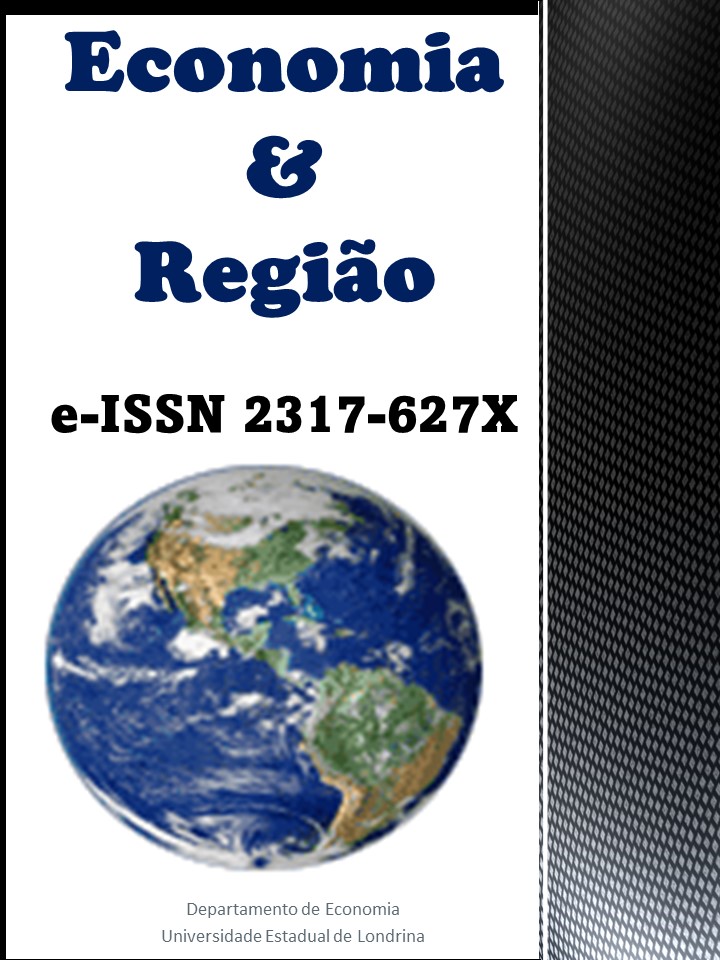Theoretical contribution of fundamental analysis and Post-Keynesian Macroeconomics
DOI:
https://doi.org/10.5433/2317-627X.2023.v11.n2.46122Keywords:
Fundamentalist analysis, Graham, Post-KeynesianismAbstract
Economic-financial thinking has been valued in contemporary times, thus, there is a need for a theory for subjects to make investments in assets. That said, within the portfolio allocation there is the possibility of deeper analysis, such as fundamental analysis, this respecting information from the firms that own the assets of interest, which will guarantee a status of how profitable a given asset can be, on a certain risk. , earn returns for your buyer. The purpose of this article is to contribute to the existing post-Keynesian financial theory, making comparisons with Graham's investment model, pointing out theoretical obstacles and convergences, enabling a theoretical contribution between the financial market and post-Keynesianism. It was noticed, during the research, that conceptual details between the two proposed references could guarantee a certain challenge in the construction of a theoretical synthesis, so that it was always sought to compare the two theoretical bases to guarantee the understanding of how they are related.
Downloads
References
ALVES JUNIOR, Antonio Jose; FERRARI FILHO, Fernando; PAULA, Luiz Fernando Rodrigues de. Crise cambial, instabilidade financeira e reforma do sistema monetário internacional: uma abordagem pós-keynesiana. Revista de economia contemporânea. Rio de Janeiro. Vol. 4, n. 1 (jan./jun. 2000), p. 79-106, 2000.
ALVES, Luiz Henrique Leal Rodrigues. Teoria moderna de portfólio aplicada ao mercado brasileiro: Markowitz vs diversificação ingênua. 2015.
ANTONIK, Luis Roberto. Análise de projetos de investimento sob condições de risco. Revista da FAE, v. 7, n. 1, 2004.
ASSAF NETO, Alexandre. Estrutura e análise de balanços: um enfoque econômico-financeiro. 8. ed. São Paulo: Atlas, 2007.
BLUME, Marshall E. Stock returns and dividend yields: Some more evidence. The Review of Economics and Statistics, p. 567-577, 1980.
BRUE, Stanley. História do Pensamento Econômico, ed. Thomson, SP, 2005.
DAVIDSON, Paul. Is probability theory relevant to uncertainty? A post Keynesian perspective. Journal of Economic Perspectives, v. 5, n. 1, p. 129-143, 1991.
DE AZEVEDO, Laís Fernanda; CONCEIÇÃO, Octavio Augusto Camargo. Incerteza e não-ergodicidade: as perspectivas das vertentes institucionalistas. Revista de Economia, v. 38, n. 67, 2019.
DEQUECH, D. Neoclassical, mainstream, orthodox, and heterodox economics. Journal of Post Keynesian Economics, v. 30, p. 279-302, 2007.
DEQUECH, David. Financial conventions in Keynes's theory: the stock exchange. Journal of Post Keynesian Economics, v. 33, n. 3, p. 469-490, 2011.
DOUGLAS, Niall. In light of current evidence, critically examine the efficient market hypothesis. Apr, v. 10, p. 1-7, 2007.
FERRARI FILHO, Fernando; DE ARAUJO, Jorge Paulo. Caos, incerteza e teoria pós-keynesiana. Ensaios FEE, v. 21, n. 2, p. 163-182, 2000.
GRAHAM, Benjamin. O Investidor Inteligente: Atualizado com novos comentários de Jason Zweig; prefácio e apêndice de Warren E. Buffet. Rio de Janeiro: Happercollins Brasil, 2016.
GRAHAM, Benjamin et al. Security analysis. New York: McGraw-Hill, 1934.
KEYNES, John Maynard. A teoria geral do emprego, do juro, e da moeda [1936]. Os Economistas. Disponível em: < http://www. afoiceeomartelo. com.
br/posfsa/Autores/Keynes,% 20John/Keynes, 1992. Acesso em: 29/07/2020.
MACHINA, Mark J., Choice Under Uncertainty: Problems Solved and Unsolved. Journal of Economic Perspectives, vol. 1, p.121-154, 1987.
MALKIEL, Burton G. Efficient market hypothesis. In: Finance. Palgrave Macmillan, London, 1989. p. 127-134.
MALTA, Tanira Lessa; DE CAMARGOS, Marcos Antônio. Variáveis da análise fundamentalista e dinâmica e o retorno acionário de empresas brasileiras entre 2007 e 2014. REGE-Revista de Gestão, v. 23, n. 1, p. 52-62, 2016.
MARÇAL, Ronan Reis; BATISTA, Tayná Cruz. Relevância da informação contábil no mercado de capitais brasileiro: uma perspectiva por meio da análise fundamentalista em empresas do índice IBrX-50. Revista de Contabilidade e Gestão Contemporânea UFF, v. 2, n. 2, p. 52-65, 2019.
MILARÉ, Luís Felipe Lopes. A (im) previsibilidade da crise e o pluralismo da Economia. Brazilian Journal of Political Economy, v. 33, n. 4, p. 659-670, 2013.
MILLER, Merton H.; MODIGLIANI, Franco. Dividend policy, growth, and the valuation of shares. The Journal of Business, v. 34, n. 4, p. 411-433, 1961.
OLESEN, Finn. Uncertainty bounded rationality and post-Keynesian Macroeconomics. European Journal of Economics and Economic Policies: Intervention, v. 7, n. 1, p. 109-124, 2010.
OREIRO, José Luís. Economia pós-keynesiana: origem, programa de pesquisa, questões resolvidas e desenvolvimentos futuros. Ensaios FEE, v. 32, n. 2, 2011.
PILKINGTON, Philip Clarke. Endogenous Money and the Natural Rate of Interest: The Reemergence of Liquidity Preference and Animal Spirits in the Post-Keynesian Theory of Capital Markets. Levy Economics Institute, Working Papers Series, 2014.
PINETTI, Camilla Garcia. O risco sistêmico no foco da regulação financeira pós-crise. Revista da Faculdade de Direito, Universidade de São Paulo, v. 110, p. 819-847, 2015.
PINHO, Carlos et al. Risco Financeiro-Medida e Gestão. Lisboa: Edições Sílabo, 2011.
PIOTROSKI, J.D. Discussion of "Separating Winners from Losers among Low Book-to-Market Stocks using Financial Statement Analysis". Rev Acc Stud 10, 171-184 (2005). https://doi.org/10.1007/s11142-005-1527-3.
POITRAS, Geoffrey. The philosophy of investment: a Post Keynesian perspective. Journal of Post Keynesian Economics, v. 25, n. 1, p. 105-121, 2002.
POSSAS, Mario Luiz. Uma interpretação de pontos controversos da Teoria Geral de Keynes. Brazilian Keynesian Review, v. 1, n. 1, p. 71-95, 2015.
RUSSEL, Philip S.; TORBEY, Violet M. The efficient market hypothesis on trial: A survey. Business Quest Journal, p. 1-19, 2002.
SHETH, Jagdish; PARVATIYAR, Atul. Handbook of Relationship Marketing. London: Sage Publications, Inc., 2000.
SICSÚ, João. Keynes e os novos-keynesianos. Revista de Economia Política, v. 19, n. 2, p. 74, 1999.
TESTA, Carlos Henrique Rodrigues. Aplicação da estratégia de investimento de Graham à BM&FBovespa para o pequeno investidor. SemeAD-Seminários em Administração, v. 14, p. 1-12, 2011.
VERSIGNASSI, Alexandre. Crash 2a edição. Leya, 2015.
VOLPI, José Henrique. Particularidades sobre o temperamento, a personalidade e o caráter, segundo a psicologia corporal. Centro Reichiano, 2004.
WOODS, J. E. JM Keynes' influence on institutional portfolio management. Journal of Post Keynesian Economics, v. 41, n. 1, p. 56-82, 2018.
WALTER, Richard G. Análise fundamentalista e avaliação de títulos: aspectos teóricos. Revista de Administração de Empresas, v. 14, p. 15-32, 1974.
Downloads
Published
How to Cite
Issue
Section
License
Copyright (c) 2023 Economia & Região

This work is licensed under a Creative Commons Attribution 4.0 International License.
Economia & Região adota a Licença Creative Commons Attribution CC-BY 4.0 International, portanto, os direitos autorais relativos aos artigos publicados são do(s) autor(es), que cedem à Revista Economia & Região o direito de exclusividade de primeira publicação.
Sob essa licença é possível: Compartilhar - copiar e redistribuir o material em qualquer suporte ou formato. Adaptar - remixar, transformar, e criar a partir do material, atribuindo o devido crédito e prover um link para a licença e indicar se mudanças foram feitas.




















